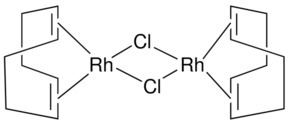Formula C16H24Cl2Rh2 Density 1.93 g/cm³ | Molar mass 493.0806 g/mol Melting point 243 °C | |
 | ||
Classification Transition metal alkene complex | ||
Cyclooctadiene rhodium chloride dimer is the organorhodium compound with the formula Rh2Cl2(C8H12)2, commonly abbreviated [RhCl(COD)]2 or Rh2Cl2(COD)2. This yellow-orange, air-stable compound is a widely used precursor to homogeneous catalysts.
Contents
Preparation and reactions
The synthesis of [RhCl(COD)]2 involves heating a solution of hydrated rhodium trichloride with 1,5-cyclooctadiene in aqueous ethanol in the presence of sodium carbonate:
2 RhCl3·3H2O + 2 COD + 2 CH3CH2OH + 2 Na2CO3 → [RhCl(COD)]2 + 2 CH3CHO + 8 H2O + 2 CO2 + 4 NaCl[RhCl(COD)]2 is principally used as a source of the electrophile "[Rh(COD)]+."
[RhCl(COD)]2 + nL → [LnRh(COD)]+Cl− (where L = PR3, alkene, etc. and n = 2 or 3)In this way, chiral phosphines such as chiraphos, DIPAMP, and DIOP have been attached to Rh. The resulting chiral catalysts are capable of asymmetrically hydrogenating certain prochiral alkenes. A closely related but still more reactive complex is chlorobis(cyclooctene)rhodium dimer.
Structure
The molecule consists of a pair of square planar Rh centers bound to a 1,5-cyclooctadiene and two chloride ligands that are shared between the Rh centers. The Rh2Cl2 core is also approximately planar, in contrast to the highly bent structure of cyclooctadiene iridium chloride dimer where the dihedral angle is 86°.
